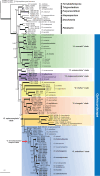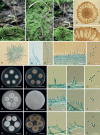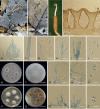Uncovering cryptic species diversity of Ophiocordyceps (Ophiocordycipitaceae) associated with Coleoptera from Thailand
- PMID: 39830293
- PMCID: PMC11736259
- DOI: 10.3114/fuse.2024.14.15
Uncovering cryptic species diversity of Ophiocordyceps (Ophiocordycipitaceae) associated with Coleoptera from Thailand
Abstract
This study advances our understanding of Ophiocordyceps, an extensively studied entomopathogenic fungus within the Ophiocordycipitaceae, particularly in Thailand. We introduce seven novel species associated with Coleoptera - O. albostroma, O. brunnea, O. capilliformis, O. kohchangensis, O. phitsanulokensis, O. pseudovariabilis, and O. ratchaburiensis. Remarkably, O. brunnea, O. kohchangensis, and O. ratchaburiensis exhibit ascomata on the subterminal region of the stromata, with the asexual form appearing at the apex of the stipe, reminiscent of O. brunneipunctata. In contrast, O. phitsanulokensis produces its ascomata in the upper region of the stipe. Shared traits include immersed perithecia and part-spores production. Ophiocordyceps albostroma and O. pseudovariabilis produce pseudo-immersed perithecia, with the former producing ascospores breaking into four part-spores, and the latter displaying 32 part-spores. Ophiocordyceps capilliformis is also introduced due to morphological distinctions from closely related species. Phylogenetic analyses based on multigene loci (LSU, TEF1, RPB1, RPB2) robustly confirm the placement of these new species within Ophiocordyceps. Additionally, we report a new record of O. clavata in Thailand. Citation: Mongkolsamrit S, Noisripoom W, Tasanathai K, Khonsanit A, Thanakitpipattana D, Lamlertthon S, Himaman W, Crous PW, Stadler M, Luangsa-ard JJ (2024). Uncovering cryptic species diversity of Ophiocordyceps (Ophiocordycipitaceae) associated with Coleoptera from Thailand. Fungal Systematics and Evolution 14: 223-250. doi: 10.3114/fuse.2024.14.15.
Keywords: Ascomycota; Coleoptera; Ophiocordyceps; new taxa; pathogenic fungi; phylogeny.
© 2024 Westerdijk Fungal Biodiversity Institute.
Figures









Similar articles
-
Revisiting Metarhizium and the description of new species from Thailand.Stud Mycol. 2020 May 5;95:171-251. doi: 10.1016/j.simyco.2020.04.001. eCollection 2020 Mar. Stud Mycol. 2020. PMID: 32855740 Free PMC article.
-
Novel and interesting Ophiocordyceps spp. (Ophiocordycipitaceae, Hypocreales) with superficial perithecia from Thailand.Stud Mycol. 2018 Mar;89:125-142. doi: 10.1016/j.simyco.2018.02.001. Epub 2018 Feb 17. Stud Mycol. 2018. PMID: 29910519 Free PMC article.
-
Three new species of Ophiocordyceps (Hypocreales, Ophiocordycipitaceae) and a new host record for Hirsutellavermicola from China.MycoKeys. 2025 May 13;117:289-313. doi: 10.3897/mycokeys.117.144875. eCollection 2025. MycoKeys. 2025. PMID: 40400764 Free PMC article.
-
Phylogenetic and morphological classification of Ophiocordyceps species on termites from Thailand.MycoKeys. 2019 Jul 29;56:101-129. doi: 10.3897/mycokeys.56.37636. eCollection 2019. MycoKeys. 2019. PMID: 31402842 Free PMC article.
-
New mycoparasitic species in the genera Niveomyces and Pseudoniveomycesgen. nov. (Hypocreales: Cordycipitaceae), with sporothrix-like asexual morphs, from Thailand.Fungal Syst Evol. 2023 Nov;12:91-110. doi: 10.3114/fuse.2023.12.07. Epub 2023 Aug 28. Fungal Syst Evol. 2023. PMID: 38533477 Free PMC article.
Cited by
-
Overview of hirsutella-like anamorphs in Ophiocordyceps (Sordariomycetes, Ophiocordycipitaceae): introducing two new species and one new record from China.MycoKeys. 2025 Jul 1;119:95-121. doi: 10.3897/mycokeys.119.145174. eCollection 2025. MycoKeys. 2025. PMID: 40641592 Free PMC article.
-
Multi-locus molecular phylogenetic analysis reveals four new species and a new record of Ophiocordyceps (Ophiocordycipitaceae, Hypocreales) on dipteran hosts in Thailand.MycoKeys. 2025 Jul 7;119:235-261. doi: 10.3897/mycokeys.119.155439. eCollection 2025. MycoKeys. 2025. PMID: 40666087 Free PMC article.
References
-
- Araújo JPM, Evans HC, Fernandes IO, et al. (2020). Zombie-ant fungi cross continents: II. Myrmecophilous hymenostilboid species and a novel zombie lineage. Mycologia 112: 1138–1170. - PubMed
-
- Araújo JPM, Evans HC, Geiser DM, et al. (2015). Unravelling the diversity behind the Ophiocordyceps unilateralis (Ophiocordycipitaceae) complex: three new species of zombie-ant fungi from the Brazilian Amazon. Phytotaxa 220: 224–238.
LinkOut - more resources
Full Text Sources
Miscellaneous
